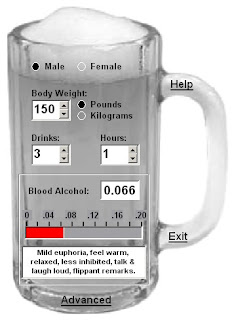How Alcohol Affects Other Parts Of The Body
In addition to the brain, alcohol can affect other body tissues. It has the following effects on other systems in the body:
- Irritates the linings of the stomach and intestine - This can lead to vomiting.
- Increases blood flow to the stomach and intestines - This increases secretions by these organs, most notably stomach acid secretion.
- Increases blood flow to the skin - This causes a person to sweat and look flushed. The sweating causes body heat to be lost, and the person's body temperature may actually fall below normal.
- Reduces blood flow to muscles - This can lead to muscle aches, most notably when a person recovers from the alcohol (the "hangover").
http://www.rupissed.com/thebody.html
Distribution
Elimination
Main Points:
- Alcohol Increases blood flow to the skin. The sweating causes body heat to be lost, and the person's body temperature may actually fall below normal. (THIS means that there will be sweat there which could test the blood alcohol level on the user)
- Absorbed alcohol is carried all throughout the body in the blood stream. Once the alcohol has been fully absorbed, blood at all points in the system contains the same concentration of alcohol. (THIS means that measuring from the wrist will retrieve the same result as it would from another area of the body.)
This research means that I am able to assume it is possible to use sweat from a persons wrist to calculate their blood alcohol level at any particular time. This eliminate the need for the device to need to hang from the users neck as we no longer need to measure breath.
The wristband will have a sweat reader/detecter on the back of the screen face, which can absorb and calculate the blood to alcohol level from the sweat.
Alcohol has a high affinity for water and is therefore found in body tissues and fluids inasmuch as they contain water. Absorbed alcohol is rapidly carried throughout the body in the blood and once absorption of alcohol is complete an equilibrium occurs such that blood at all points in the system contains approximately the same concentration of alcohol.
Elimination
The liver is responsible for the elimination - through metabolism - of 95% of ingested alcohol from the body. The remainder of the alcohol is eliminated through excretion of alcohol in breath, urine, sweat, feces, milk and saliva. The body uses several different metabolic pathways in its oxidation of alcohol to acetaldehyde to acetic acid to carbon dioxide and water.
http://www.intox.com/t-Physiology.aspxMain Points:
- Alcohol Increases blood flow to the skin. The sweating causes body heat to be lost, and the person's body temperature may actually fall below normal. (THIS means that there will be sweat there which could test the blood alcohol level on the user)
- Absorbed alcohol is carried all throughout the body in the blood stream. Once the alcohol has been fully absorbed, blood at all points in the system contains the same concentration of alcohol. (THIS means that measuring from the wrist will retrieve the same result as it would from another area of the body.)
This research means that I am able to assume it is possible to use sweat from a persons wrist to calculate their blood alcohol level at any particular time. This eliminate the need for the device to need to hang from the users neck as we no longer need to measure breath.
The wristband will have a sweat reader/detecter on the back of the screen face, which can absorb and calculate the blood to alcohol level from the sweat.

No comments:
Post a Comment